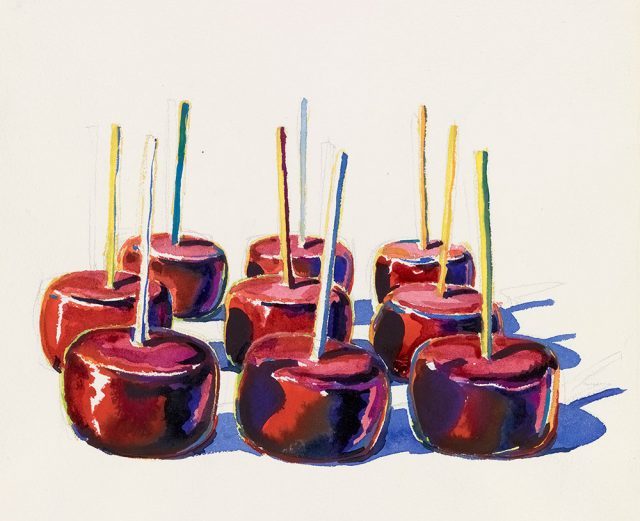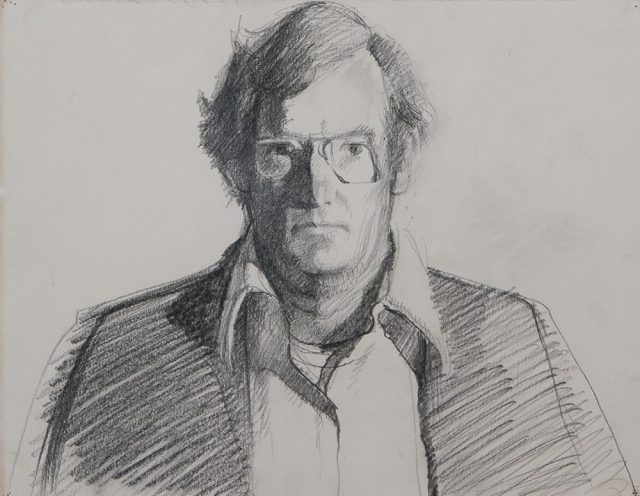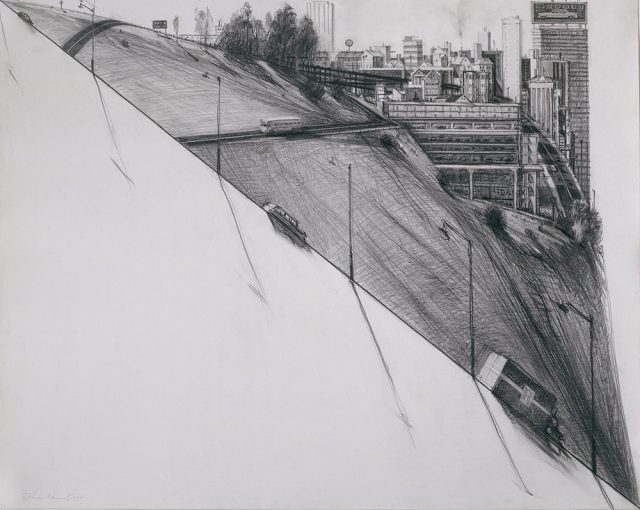
Wayne Thiebaud, “Nine Jelly Apples,” watercolor and graphite, 1964 (Yale University Art Gallery, Gift of George Hopper Fitch, B.A. 1932. Photography by Tony De Camillo. © Wayne Thiebaud/Licensed by VAGA, New York, NY)
Morgan Library & Museum
225 Madison Ave. at 36th St.
Tuesday – Sunday through September 23, $13-$20 (free Fridays 7:00 to 9:00)
212-685-0008
www.themorgan.org
You might be surprised to find out that from 2005 to 2015, Wayne Thiebaud was sixth on the list of top-selling living American artists at auction, totaling more than $163 million in aggregated sales (trailing Jeff Koons, Christopher Wool, Richard Prince, Ed Ruscha, and Jasper Johns and ahead of Robert Ryman, Frank Stella, Robert Indiana, and Cindy Sherman). Or maybe that’s not surprising at all, given how his oeuvre is so viscerally pleasing while also technically adroit, as revealed in the lovely exhibition “Wayne Thiebaud, Draftsman,” continuing at the Morgan through September 23. Now ninety-seven and still working, the Arizona-born, California-raised artist is best known for his luscious paintings of pies, jelly apples, ice-cream cones, and other tasty treats, but the show reveals him to be an expert draftsman through drawings and sketches not only of desserts but of cityscapes and landscapes. His influences range from Willem de Kooning, Franz Kline, Giorgio Morandi, Edgar Degas, and Pierre-Paul Prudh’hon to Krazy Kat cartoonist George Herriman and time spent in trade school and the military and as a commercial artist, window dresser, and graphic designer for Rexall Drugs and Universal Studios. “One day [printer] Kathan [Brown] brought down lunch, which was a cheese sandwich, a couple of olives, and a beer, and I said, ‘Before we eat this, I think I’ll draw it,’” Thiebaud is quoted as saying in the exhibition catalog.

Wayne Thiebaud, “Self Portrait,” graphite, ca. 1970 (From the artist’s studio. © Wayne Thiebaud/Licensed by VAGA, New York, NY)
The show, the first extensive museum survey of Thiebaud’s works on paper, is a panoply of delights, from the 1964 watercolor and graphite “Nine Jelly Apples,” in which the sweet jelly seems to be dripping down the wall, to the 1983 charcoal “Three Roads,” an imaginative rendering of San Francisco streets, from a circa-1970 graphite self-portrait of Thiebaud looking serious to the 1960s-1970s “Page of Sketches with Ties,” four rectangular depictions of numerous ties, from the 1964 brush and ink “Hamburgers,” three rows of the all-American food, to the fantastical 1967-68 “Ridge with Clouds.” Thiebaud is not making any grand statements about consumption or hunger; the self-effacing artist and teacher is merely using his impressive skill to explore various subjects and styles. He also seems to have a penchant for drawing items in multiples of three, although he claims that is not on purpose and has no secret meaning. “Learning to draw is just learning to see more clearly and more organized,” he told curator Isabelle Dervaux in an illustrated talk at the Morgan. “That’s another side benefit of learning to draw. You’re going to learn to see a lot better and a lot deeper.”

Wayne Thiebaud, “Diagonal City,” graphite, 1978 (Collection of Harry W. and Mary Margaret Anderson. © Wayne Thiebaud/ Licensed by VAGA, New York, NY)
Thiebaud’s works have a way of getting inside your head, offering up sweet memories. Walking through the exhibit, I was like, well, a kid in a candy store. I thought of the first hamburger I had at Wetson’s, of the candy store down the street from my elementary school, of how rarely I saw my father wearing a tie, of a cake my aunt used to make for my birthday, the first time I licked an ice-cream cone and the ice cream dripped onto my hand, of a childhood friend’s dog, and of getting lost while wandering through parts of San Francisco and New York City. Dervaux has done a marvelous job laying out the show, dividing it into such themes as “Foodstuff,” “Tradition,” “Early Drawings,” and “Cityscapes and Landscapes,” creating compelling juxtapositions that tell us yet more about Thiebaud and his methods. It’s a joy to experience these works, many of which have never before been shown publicly. “Most of these are private drawings — to find out something, to make notations, or just to experiment,” Thiebaud has said. “You want to feel that these are things that will never be seen.”